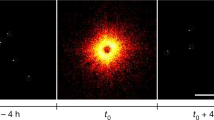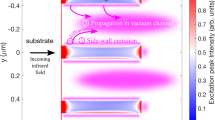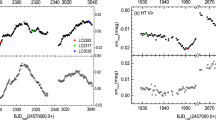Abstract
SEVERAL classes of interacting binary stars, such as the dwarf novae, nova-like variable stars and X-ray stars, present many examples of rapid periodic optical variations. DQ Herculis (nova 1934) is, however, the only nova known to show such variations. They are of low amplitude, generally less than 0.04 mag semi-amplitude, and have a period of 71.065459 s (refs 1–3). We report here a study of the harmonic components of the 71-s periodicity, and show that the results place severe limits on the available models of the variation.
Similar content being viewed by others
Article PDF
References
Walker, M. F., Astrophys. J., 123, 68–89 (1956).
Nather, R. E., and Warner, B., Mon. Not. R. astr. Soc., 143, 145–165 (1969).
Warner, B., Peters, W. L., Hubbard, W. B., and Nather, R. E., Mon. Not. R. astr. Soc., 159, 321–335 (1972).
Nather, R. E., and Warner, B., Mon. Not. R. astr. Soc., 152, 209–217 (1971).
Bath, G. T., Evans, W. D., and Pringle, J. E., Mon. Not. R. astr. Soc., 166, 113–121 (1974).
Lamb, D. Q., Astrophys. J. Lett., 192, L129–L133 (1974).
Kemp, J. C., Swedlund, J. B., and Wolstencroft, R. D., Astrophys. J. Lett., 193, L15–L19 (1974).
Herbst, W., Hesser, J. E., and Ostriker, J. P., Astrophys. J., 193, 679–686 (1974).
Author information
Authors and Affiliations
Rights and permissions
About this article
Cite this article
KIPLINGER, A., NATHER, R. Harmonic analysis of the light of DQ Herculis. Nature 255, 125 (1975). https://doi.org/10.1038/255125a0
Received:
Accepted:
Issue date:
DOI: https://doi.org/10.1038/255125a0



